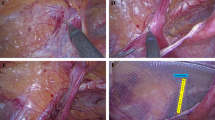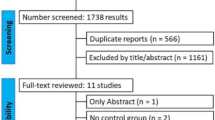Abstract
Background
Whether to preserve the uterine round ligament during laparoscopic inguinal hernia repair in women is controversial. In this study, we aimed to compare outcomes of uterine round ligament preservation versus transection during such surgery and to explore the impact and long-term outcomes of transecting the round ligament.
Methods
The study cohort comprised 419 women who had undergone laparoscopic inguinal hernia repair in Beijing Chaoyang Hospital and Qilu Hospital from January 2013 to January 2020; 393 (93.8%) of whom were successfully followed up. Patient characteristics and technical details of the operative procedure were collected and analyzed retrospectively. Early and late postoperative follow-up data, complications, especially symptoms related to retroflexed uterus, and fertility outcomes, were collected by a single follow-up nurse who was blinded to the operative procedure.
Results
There were 218 women (239 sides) in the uterine round ligament preservation group and 175 (182 sides) in the transection group. The patients in the preservation group were younger (45.9 vs. 53.6 years, p = 0.000), and had lower American Society of Anesthesiologists scores (p = 0.000). The median follow-up times in the preservation and transection groups were 41.8 ± 24.2 and 42.7 ± 24.6 months, respectively (p = 0.692). Compared with the transection group, the preservation group had longer operative times for repair of both primary and recurrent hernias. Intraoperative bleeding, length of hospital stay, development of seromas, recurrence rate, incidence of postoperative pain at the first and third postoperative months, and time of last outpatient visit were similar in the two groups. There were more premenopausal patients in the preservation group; however, we found no evidence that transection of the round ligament affected subsequent pregnancy or childbirth. Moreover, we identified no differences in dyspareunia, dysmenorrhea, chronic pelvic pain, or uterine prolapse.
Conclusion
Transection of the round ligament during laparoscopic inguinal hernia repair in women does not increase the incidence of dyspareunia, dysmenorrhea, chronic pelvic pain, or uterine prolapse, whereas it has the advantage of reducing the operation time.
Similar content being viewed by others
References
Nilsson E, Kald A, Anderberg B, Bragmark M, Fordell R, Haapaniemi S, Heuman R, Lindhagen J, Stubberöd A, Wickbom J (1997) Hernia surgery in a defined population: a prospective three year audit. Eur J Surg 163(11):823–829
He Z, Hao X, Feng B, Li J, Sun J, Xue P, Yue F, Yan X, Wang J, Zheng M (2019) Laparoscopic repair for groin hernias in female patients: a single-center experience in 15 years. J Laparoendosc Adv Surg Tech A 29(1):55–59
HerniaSurge Group (2018) International guidelines for groin hernia management. Hernia 22(1):1–165
Yang X-F, Liu J-L (2016) Laparoscopic repair of inguinal hernia in adults. Ann Transl Med 4(20):402
Yen C-F, Wang C-J, Lin S-L, Lee C-L, Soong Y-K (2002) Combined laparoscopic uterosacral and round ligament procedures for treatment of symptomatic uterine retroversion and mild uterine decensus. J Am Assoc Gynecol Laparosc 9(3):359–366
Halperin R, Padoa A, Schneider D, Bukovsky I, Pansky M (2003) Long-term follow-up (5–20 years) after uterine ventrosuspension for chronic pelvic pain and deep dyspareunia. Gynecol Obstet Invest 55(4):216–219
Li J, Tao C (2020) Uterus-containing inguinal hernia caused by undue tension on round ligament. Int J Abdom Wall Hernia Surg 3:114–117
Fauconnier A, Dubuisson J-B, Foulot H, Deyrolles C, Sarrot F, Laveyssière M-N, Jansé-Marec J, Bréart G (2006) Mobile uterine retroversion is associated with dyspareunia and dysmenorrhea in an unselected population of women. Eur J Obstet Gynecol Reprod Biol 127(2):252–256
Porpora MG, Gomel V (1997) The role of laparoscopy in the management of pelvic pain in women of reproductive age. Fertil Steril 68(5):765–779
Alexey VA, Bashankaev B (2019) Laparoscopic round ligament preserving repair for groin hernia in women: a critical appraisal. Int J Abdom Wall Hernia Surg 2:130
Guo M, Chen D, Zhang H, Lu C (2019) Safety and efficiency of laparoscopic femoral hernia repair with preserved uterine round ligament. J Coll Physicians Surg Pak 29(10):932–936
Ando H, Kaneko K, Ito F, Seo T, Ito T (1997) Anatomy of the round ligament in female infants and children with an inguinal hernia. Br J Surg 84(3):404–405
Bittner R, Montgomery M, Arregui E, Bansal V, Bingener J, Bisgaard T, Buhck H, Dudai M, Ferzli G, Fitzgibbons RJ (2015) Update of guidelines on laparoscopic (TAPP) and endoscopic (TEP) treatment of inguinal hernia. Surg Endosc 29(2):289–321
Schmidt L, Andresen K, Öberg S, Rosenberg J (2018) Dealing with the round ligament of uterus in laparoscopic groin hernia repair: a nationwide survey among experienced surgeons. Hernia 22(5):849–855
Arruda KA, Cataneo DC, Cataneo AJM (2013) Surgical risk tests related to cardiopulmonary postoperative complications: comparison between upper abdominal and thoracic surgery. Acta Cir Bras 28(6):458–466
Viste A, Haùgstvedt T, Eide GE, Søreide O (1988) Postoperative complications and mortality after surgery for gastric cancer. Ann Surg 207(1):7–13
Jackson TD, Wannares JJ, Lancaster RT, Rattner DW, Hutter MM (2011) Does speed matter? The impact of operative time on outcome in laparoscopic surgery. Surg Endosc 25(7):2288–2295
Junge K, Klinge U, Rosch R, Klosterhalfen B, Schumpelick V (2002) Functional and morphologic properties of a modified mesh for inguinal hernia repair. World J Surg 26(12):1472–1480
Acknowledgements
We thank Dr Trish Reynolds, MBBS, FRACP, from Liwen Bianji, Edanz Group China (www.liwenbianji.cn/ac), for editing the English text of a draft of this manuscript.
Funding
This study was supported by fellowships from the China Postdoctoral Science Foundation (Grant No. 2020M682191) and Key Research and Development Project of Shandong Province (Grant No. 2019GSF108151).
Author information
Authors and Affiliations
Corresponding authors
Ethics declarations
Disclosures
Authors Yuchen Liu, Junying Liu, Qian Xu, Binbin Zhang, Minggang Wang, Guanyong Zhang and Zhibo Yan have no conflicts of interest or financial ties to disclose.
Additional information
Publisher's Note
Springer Nature remains neutral with regard to jurisdictional claims in published maps and institutional affiliations.
Rights and permissions
About this article
Cite this article
Liu, Y., Liu, J., Xu, Q. et al. Objective follow-up after transection of uterine round ligament during laparoscopic repair of inguinal hernias in women: assessment of safety and long-term outcomes. Surg Endosc 36, 3798–3804 (2022). https://doi.org/10.1007/s00464-021-08696-4
Received:
Accepted:
Published:
Issue Date:
DOI: https://doi.org/10.1007/s00464-021-08696-4




